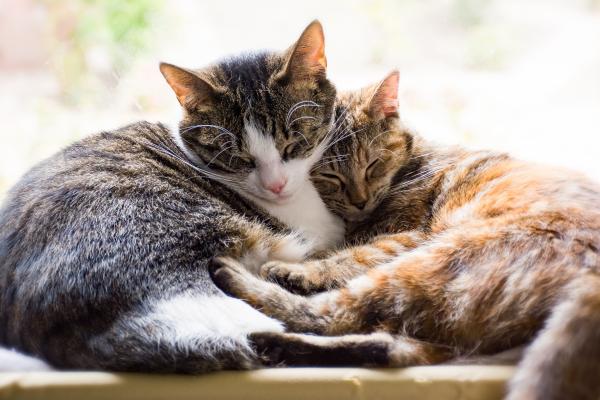Should You Get Two Male Cats or a Male and Female Pair?



See files for Cats
Choosing the right cat combination affects your pets' happiness and your home life. While two male cats can form strong bonds through play and companionship, a male-female pair often creates naturally balanced relationships. Your decision should rest on your current cat's personality, your living space, and your ability to manage different cat dynamics. Both pairings can work well, but each brings distinct challenges and rewards. Understanding these differences helps you make an informed choice that fits your situation.
The following AnimalWised article explores whether you should get two male cats or a male and female pair, what makes each combination unique, and how to set your cats up for success.
Key differences between male and female cats
Understanding male and female cat dynamics can help you choose the right pair. Male cats typically show affection openly by headbutting you, sitting in your lap, and following you around the house. After neutering, males get along well with other cats and stay calmer at home.
Female cats express themselves differently. They value their space while staying close on their own terms. Most females observe their family from a comfortable distance and maintain clear boundaries with other cats. When pairing cats, these different styles can either complement or clash depending on the individuals.
How cats form bonds
When introducing two cats, their bonding process follows natural patterns. Here's what helps them become friends:
- Early learning: during weeks 2-7, cats develop their social skills. Cats who share positive early experiences with others often make better companions as adults.
- Scent marking: new cat pairs build trust by sharing scents. They rub against each other and their surroundings to create a shared family smell in your home.
- Body language: watch how your cats interact - slow blinks, exposed bellies, or choosing to sleep near each other show growing trust. These signs indicate your cats are becoming comfortable together.
- Daily connection: strong bonds develop through shared routines. When your cats eat, play, and rest together regularly, they're more likely to form a lasting friendship.
Wondering if your cat is ready for a companion? Our guide reveals the subtle hints your cat gives when they want a furry friend.
Male and female cats
Two neutered male cats often make excellent companions, but their success depends heavily on their individual personalities and ages.
Males typically form strong social bonds through play and shared activities. They'll chase each other, wrestle, and burn off energy together - which means less 3 AM zoomies for you to deal with.
Active male cats often welcome new male companions, particularly kittens. When both cats enjoy high energy play, they'll keep each other entertained and exercise together. However, if you have a calm adult male, another high-energy male (especially a kitten) might stress him out.
However, territory issues can arise between male cats, particularly if either cat isn't neutered. Unneutered males show more territorial behavior than females and may mark their space with urine or start fights. Even neutered males might have disputes around litter boxes and feeding areas.
To help two males live together peacefully, you'll need:
- Multiple litter boxes in different locations
- Separate food and water stations
- Personal space options like cat trees, window perches, and hiding spots
- Individual play sessions to prevent competition
- A careful introduction process
Age matching matters too. Consider adopting siblings who can grow up together, or pair cats with similar energy levels and backgrounds. If your resident male is calm, you might want to consider a female companion instead, since they often create more relaxed households.

A male-female pair often creates a balanced household through complementary play styles. Males bring high energy and physical play, while females often prefer strategic games like stalking and hide-and-seek. This mix of behaviors helps both cats develop new skills and keeps them mentally stimulated.
When properly introduced, males and females often settle into natural roles. Females typically establish clear boundaries, while males adapt to these social rules. Most mixed pairs divide territory naturally, leading to a more peaceful home.
However, timing matters with mixed pairs. Both cats need to be fixed before puberty. Males become sexually active around 4-5 months, females at 6 months. Waiting too long can lead to spraying, fighting, and unwanted pregnancies. Early spaying and neutering also reduces cancer risks and promotes calmer behavior.
Activity level differences can create friction. Young males often want to play roughly or frequently, while females might prefer quieter interactions. Age matching helps prevent this issue.
For success with a male-female pair, you need:
- Both cats fixed early
- Separate resting areas for each cat
- Proper space and equipment for both cats
- Patient introductions, especially with adult cats
Young cats adapt more easily to each other, but adult pairs can still work well. With good socialization, proper introductions, and the right environment, most male-female pairs develop strong bonds. Before choosing your pair, learn which cat breeds naturally excel at forming friendships with other pets.

Tips for introducing new cats to each other
Bringing a new cat home requires patience and strategy. Success depends largely on those first few weeks of introduction.
Whether you're introducing two males or a male-female pair, the same careful approach applies:
- Space separation: set up a dedicated room for your new cat with all essential items, such as litter box, food, water, bed, and toys. Your resident cat keeps access to the rest of the house. This approach lets them adjust gradually without feeling overwhelmed.
- Help them exchange scents safely: place blankets in each cat's area, then swap them daily. Feed them on opposite sides of a closed door to build positive associations. Some cat owners find synthetic pheromone products helpful for reducing stress during this phase.
- Start brief visual introductions: after about three days of peaceful scent exchange, use a baby gate or secure barrier that prevents physical contact but allows them to see each other. Keep these sessions short and supervised. Don't worry about some hissing because it's normal and doesn't mean they'll dislike each other long-term.
- Move to physical meetings: only when both cats seem relaxed with visual contact, start with brief supervised sessions in a neutral room. Make sure each cat has escape routes and safe spaces to retreat. Reward calm behavior from both cats equally with treats or praise.
Think in weeks, not days, for the full introduction process. Most cats need 2-4 weeks to adjust, but some might need months. Forcing interactions or rushing the process often creates long-term problems. Your patience now builds the foundation for years of friendship between your cats.
Remember to treat both cats equally throughout the process. The resident cat shouldn't feel replaced, and the newcomer needs to feel welcome. Let them set the pace for their relationship. When they start grooming each other, sharing spaces, or playing together, you'll know your careful introduction has succeeded.
Did your cats start off on the wrong paw? Discover effective techniques to help them build a peaceful relationship.
If you want to read similar articles to Should You Get Two Male Cats or a Male and Female Pair?, we recommend you visit our Comparisons category.







